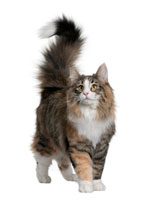The Liver and Pancreas
 The liver is an amazing organ. One of the largest in the body, it is responsible for many functions which are essential for life. Food subunit storage, detoxification of poisons coming into the bloodstream from the gut, and food subunit processing are just a few of these. Breakdown of dietary fats to fatty acid components is assisted by the bile produced in the liver, and released into the gut. The liver can also regenerate very well (unlike some of the other body tissues). This means that short term insults may fully heal.
The liver is an amazing organ. One of the largest in the body, it is responsible for many functions which are essential for life. Food subunit storage, detoxification of poisons coming into the bloodstream from the gut, and food subunit processing are just a few of these. Breakdown of dietary fats to fatty acid components is assisted by the bile produced in the liver, and released into the gut. The liver can also regenerate very well (unlike some of the other body tissues). This means that short term insults may fully heal.
The pancreas is another dynamo! Located next to the stomach and small intestine, it is a thin, soft organ which packs in dual function as an exocrine gland (releases enzymes to digestive tract) and endocrine gland (releases hormones to bloodstream). The most famous hormone from the pancreas is insulin. This hormone has many effects on carbohydrate, fat, and protein metabolism (processing). Most widely recognized is high blood sugar resulting from the lack of proper action of insulin, either due to low production or due to resistance of the target tissues to its action, leading to diabetes mellitus.
The exocrine part of the pancreas is responsible for the production and release of a set of enzymes needed to break down food into small subunits. Protein breakdown to amino acids, and starches cleaved into sugars are examples of the digestive processes carried out in the gut.
When things go wrong
The organs can be affected individually by infection (hepatitis, pancreatitis) and tumors can also develop in these organs.
Here are some specific examples of selected conditions:
Cholangitis / Cholangiohepatitis Syndrome
The close relationship between liver and pancreas with the upper gut can lead to a triad of abnormalities whereby the pancreas becomes inflamed, as does the liver, and the abnormal function of these organs leads to inflammation and a change in the normal digestive system balance in the small intestine.
Cholangitis or cholangiohepatitis is a common chronic liver disorder of young to middle-aged cats. Some breeds of cats seem to be prone to this condition (Siamese, Persian and Persian-related cats). This condition affects the bile system in the liver, and can be associated with pancreatitis and inflammatory bowel disease. It may be associated with bacterial infection (suppurative) or chronic inflammation (nonsuppurative). The suppurative form is often characterized by a sudden onset of fever and malaise, while the nonsuppurative inflammatory form is more commonly a slow, progressive disorder and may require lifelong management. Gall bladder inflammation and gallstones may also occur. Treatment consists of intensive support with nutrition often given via tube feeding, supplements (including SAMe, Vitamin E, B), antibiotic (in suppurative form) and fluids and anti-inflammatory medications.
Portosystemic Shunts / Anomalies
In cats, a condition that results in abnormal blood vessel development to the liver and within the liver can seriously interfere with the organ function. These can be congenital (present at birth) or develop early in life, associated with regional high blood vessel pressure problems. With shunting, the blood supply bypasses the liver, so that toxins and other food components enter the system circulation without going into the liver for processing and detoxifying. The liver does not receive the usual nutrients from the gut for storage and nutrition and so becomes smaller in size. Some of these components that build up in the bloodstream lead to a waxing and waning central nervous disorder (hepatic encephalopathy). Signs of shunting are primarily of a digestive disturbance, and cats often drool profusely—the onset of changes usually coincides with weaning onto solid food. Kittens may be stunted in their growth. A special diagnostic procedure allows the surgeon to check the exact location of the abnormal blood vessels prior to surgery.
Treatment consists of stabilizing the abnormal behavioral signs of encephalopathy, then surgical repair of the abnormal blood vessels, though this technique may not be curative in all cases. Complications are not uncommon. Special diets are used to help decrease the protein load on the system.
Hepatic Lipidosis (Fatty Liver)
Hepatic lipidosis is a serious metabolic derangement most commonly seen in cats that are obese and go off their food. The loss of appetite can occur for many reasons, and may be associated with other diseases. The lipidosis is the result of a massive buildup in liver cells of triglycerides, the fat building blocks. If left untreated, death may result, and even with intervention, some cases cannot be reversed. Vomiting, loss of appetite and central nervous signs may occur. Drooling, collapse and jaundice may be noted. The liver becomes swollen with the fat.
Intensive care and nutritional support are used to help bring the downward spiral to a halt. Feeding tubes are generally placed for a few weeks until the cat has stabilized, though some must remain in place for up to 6 months. They are removed only after the cat has been eating well for at least 1 week.
If you are putting an obese cat on a diet, weight loss must be carefully monitored so that only SLOW loss occurs. Your veterinarian can give you specific targets to adhere to. Also, in times of household change (moving, renovations, new pets etc) watch Kitty’s food intake closely. Onset of the problem can be insidious.
Pancreatitis
In cats with pancreatitis, diagnosis can be a challenge. The chronic form of pancreatitis is most common in this species. Siamese cats may be somewhat predisposed to this condition. The signs associated with pancreatitis in cats are often vague, with lethargy, poor appetite, and weight loss commonly noted. Trauma, toxins, and infections may trigger this problem, or there may be no clear cause (idiopathic). Pancreatitis is often associated with triad disease (see Cholangitis-cholangiohepatitis above). Diagnostic tests are not as useful in cats as they are in people and dogs. Trypsin-like immunoreactivity (TLI) tests are the most specific of the lab tests, but changes are not always present in affected cats. Ultrasound-guided or surgical biopsy is often needed for a definite diagnosis. Supportive care, including nutrition and fluid therapy will be done. Pain control, antibiotic, and anti-vomiting medications may be added to the mix.
Many more conditions can affect these key organs. Your veterinarian can help you understand prognosis, treatment options and other aspects of these conditions.
You May Also Like These Articles:
Fatty Liver Disease in Cats (Hepatic Lipidosis)
How To Know When Your Cat Is Sick





